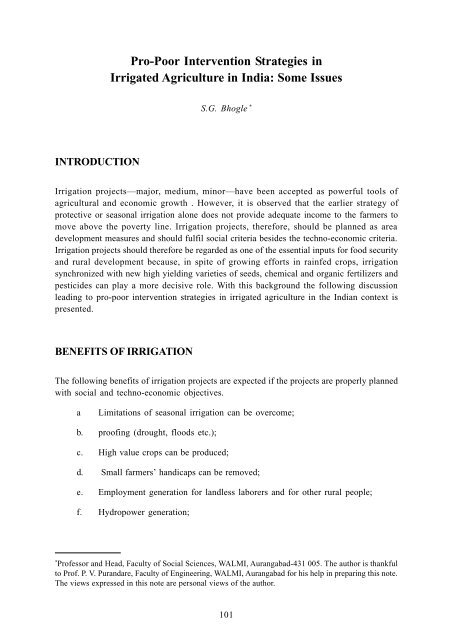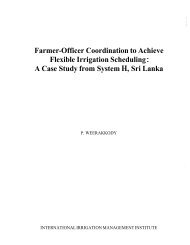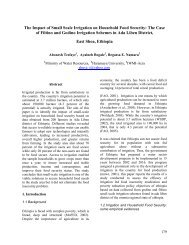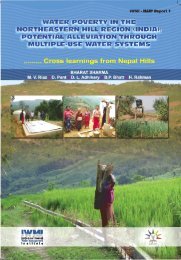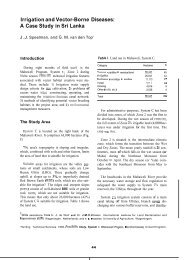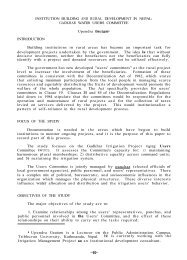S.G. Bhogle
S.G. Bhogle
S.G. Bhogle
- No tags were found...
You also want an ePaper? Increase the reach of your titles
YUMPU automatically turns print PDFs into web optimized ePapers that Google loves.
Pro-Poor Intervention Strategies in<br />
Irrigated Agriculture in India: Some Issues<br />
S.G. <strong>Bhogle</strong> *<br />
INTRODUCTION<br />
Irrigation projects—major, medium, minor—have been accepted as powerful tools of<br />
agricultural and economic growth . However, it is observed that the earlier strategy of<br />
protective or seasonal irrigation alone does not provide adequate income to the farmers to<br />
move above the poverty line. Irrigation projects, therefore, should be planned as area<br />
development measures and should fulfil social criteria besides the techno-economic criteria.<br />
Irrigation projects should therefore be regarded as one of the essential inputs for food security<br />
and rural development because, in spite of growing efforts in rainfed crops, irrigation<br />
synchronized with new high yielding varieties of seeds, chemical and organic fertilizers and<br />
pesticides can play a more decisive role. With this background the following discussion<br />
leading to pro-poor intervention strategies in irrigated agriculture in the Indian context is<br />
presented.<br />
BENEFITS OF IRRIGATION<br />
The following benefits of irrigation projects are expected if the projects are properly planned<br />
with social and techno-economic objectives.<br />
a<br />
Limitations of seasonal irrigation can be overcome;<br />
b. proofing (drought, floods etc.);<br />
c. High value crops can be produced;<br />
d. Small farmers’ handicaps can be removed;<br />
e. Employment generation for landless laborers and for other rural people;<br />
f. Hydropower generation;<br />
*<br />
Professor and Head, Faculty of Social Sciences, WALMI, Aurangabad-431 005. The author is thankful<br />
to Prof. P. V. Purandare, Faculty of Engineering, WALMI, Aurangabad for his help in preparing this note.<br />
The views expressed in this note are personal views of the author.<br />
101
102<br />
g. Boosting agro-based industries (sugar factories, rice mills etc.);<br />
h. Water supply for drinking and industrial purposes;<br />
i. Improvement in infrastructure facilities;<br />
j. Increase in fisheries, trade, transport, tourism etc.<br />
However, proper and adequate documentation of benefits due to irrigation projects has<br />
not been done meticulously and seriously. On the contrary, the ill effects or hazards due to<br />
irrigation projects are given wide publicity through excellent documentation in print and<br />
electronic media. It is therefore necessary to identify the factors which are directly or<br />
indirectly responsible for poverty alleviation. With this idea in mind the following issues/<br />
questions for taking up research studies are suggested.<br />
1. Completion of irrigation project itself is one of the prime pro-poor interventions<br />
in irrigated agriculture in India. Systematic planning for the completion of<br />
ongoing irrigation projects and provision of adequate budget is the need of the<br />
time. If irrigation projects are completed on time, the most vital step of poverty<br />
alleviation is taken. Completing “project” (and not just civil works!) in the truest<br />
sense of the term without cost-and-time-overruns would be the most fundamental<br />
and crucial pro-poor intervention. Equity and increased productivity are just not<br />
possible in the following scenario, which has become common everywhere.<br />
“Incomplete project --> poor performance --> inequitable water distribution<br />
--> tail-end problem --> faulty system --> inability to implement any good idea<br />
--> 50-60 percent rainfed area in the irrigation command --> poverty<br />
with-and-within an irrigation project.”<br />
It is therefore necessary to take an in-depth performance evaluation studies<br />
of irrigation projects to start with on a sample basis. In all the agro-climatic zones<br />
of India, one major, one medium and one minor irrigation project should be<br />
evaluated by comparing the project objectives and if the objectives are not<br />
accomplished, the lessons learnt as feed back will be useful for the redesigning<br />
of the proposed irrigation projects.<br />
2. Developing user friendly canal systems with simple hardware and software<br />
(“KISS” principle—keep it simple and stupid!) that can be understood, operated<br />
and maintained mostly by the users themselves would be the second important<br />
pro-poor intervention. This is technically feasible with the following strategy.<br />
Software<br />
Hardware<br />
Location-specific<br />
- Ungated self-regulating outlets(SRO)<br />
various combinations of - Proportionate flow dividers(PFD)<br />
- Phad - Weirs (e.g., diagonal, duck-bill)<br />
- Warabandi - Hydro-mechanical gates(e.g., AVID, AVIS)<br />
- RWS - Night storages<br />
- Limited rate demand schedules - Balancing reservoirs
103<br />
(LRDS)<br />
- Indirect flow measurement with<br />
(SRO & PFD)<br />
- Simultaneous operation of outlets<br />
- Simultaneous manual operation of<br />
motorized CRs on main canal<br />
- Low pressure underground pipe lines below outlet.<br />
A pilot action research study on a major or medium irrigation project can be taken<br />
up for evolving user- friendly canal system.<br />
3. Developing and implementing water rights compatible to—<br />
i. User-friendly systems suggested earlier.<br />
ii.<br />
Realistically revised irrigation potential.<br />
4. Evolving a better Irrigation Act which would provide for:<br />
• PIM<br />
• Right to water<br />
• Right to information<br />
• Accountability for all concerned<br />
These would also be a basic pro-poor intervention because in the absence of<br />
implementation of Irrigation Act, anarchy will prevail. A “free-for-all” situation<br />
leads to “might is right” and is, therefore, anti-poor.<br />
5. To resist privatization of irrigation or for that matter complete water sector would<br />
be a timely and most-needed pro-poor intervention. A genuine Water User<br />
Cooperative Society (WUSC) is a welcome thing but if WUCS is being used only<br />
as a stop-gap arrangement towards bringing privatization then it is an anti-poor<br />
intervention and should be resisted.<br />
6. Many socioeconomic benchmark and post-project surveys of different irrigation<br />
projects have been carried out in the last 3 decades in India. However, in almost<br />
all such studies, the contact persons for getting information/data have been<br />
farmers possessing land on his or her name. Landless laborers, small traders,<br />
artisans and rural people at large are not covered through such surveys. It is<br />
therefore suggested that such research studies be taken up in all the States of<br />
India.<br />
7. Most of the irrigation projects in India have major emphasis on providing canal<br />
water in rabi and hot weather seasons. However, one or two rotations in kharif<br />
season in the event of long dry spells can prove to be an important pro-poor<br />
intervention in irrigated agriculture. A few research studies using the technique<br />
of “case study” should be taken up so that some pro-poor policy measures in this<br />
respect can be evolved.
104<br />
8. Access to technical information such as rainfall data, availability of water in the<br />
reservoirs, rotation schedules, package of practices for all major irrigated crops,<br />
storage/processing/marketing facilities, etc. should be made available to all the<br />
rural people at no cost. This is expected to be helpful in increasing the<br />
productivity of different crops especially of poor farmers.<br />
9. It has been observed that irrigation projects are instrumental in improving the<br />
availability of drinking water to the rural as well as the urban people. This,<br />
particularly in rural areas, has helped the women folk in reducing the time spent<br />
in fetching water from distant sources. In other words, the productive work hours<br />
resulting in gainful employment have increased for women as well as men in rural<br />
areas. Research studies exactly quantifying this very important social impact<br />
should be taken up in the case of a few irrigation projects.<br />
10. For the Government of India schemes, data for population Below Poverty Line<br />
(BPL) is any way collected from rural as well as urban areas. Irrigation<br />
Departments in India have data regarding land holdings, survey number. etc., of<br />
the beneficiaries. Using both these data sets, research studies of a few irrigation<br />
projects, if taken up, will be able to exactly quantify as to how many people have<br />
been brought above the poverty line due to irrigation projects. Methodology for<br />
this purpose could be to have benchmark surveys done of a few irrigation projects<br />
at the time of their starting and then with an interval of five years such surveys<br />
can be repeated. Such data sets will reveal the contribution of irrigation projects<br />
in poverty alleviation.


